If Modi and Shah did not project Adityanath as CM, it was out of expediency, says Radhika Ramaseshan.
Illustration: Dominic Xavier/Rediff.com
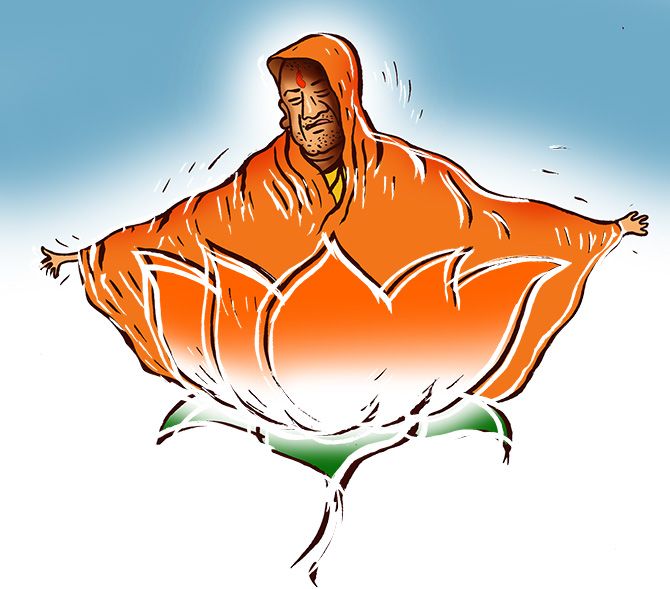
Prime Minister Narendra Modi is known to pull off surprises.
Yet, except for a clique which looks up to Amit Shah, the Bharatiya Janata Party president, as its patron, the rest of the party was stumped when Yogi Adityanath was declared the Uttar Pradesh chief minister on March 18.
Even Shah’s inner circle received the news in bits and pieces, depending on how much each member needed to know at a certain point.
From the accounts put together after speaking with members of the BJP’s parliamentary board, the apex policy and decision making body, and Shah’s associates, it appeared that Modi and he took the call in ‘unison’. And communicated it as a fait accompli to the other leaders and functionaries.
It is apparent that Adityanath’s choice was premeditated. It featured among a quartet of names that were circulated till the end.
These included Home Minister Rajnath Singh, the UP party president and Phulpur MP Keshav Prasad Maurya, and the junior railways and communications minister, Manoj Sinha.
These names might have been a feint to turn the spotlight away from Adityanath. For, as a leader put it, “There were forces that actively worked against him since 2002, fearing he might destabilise the UP BJP establishment.”
The answer to the big ‘why’?
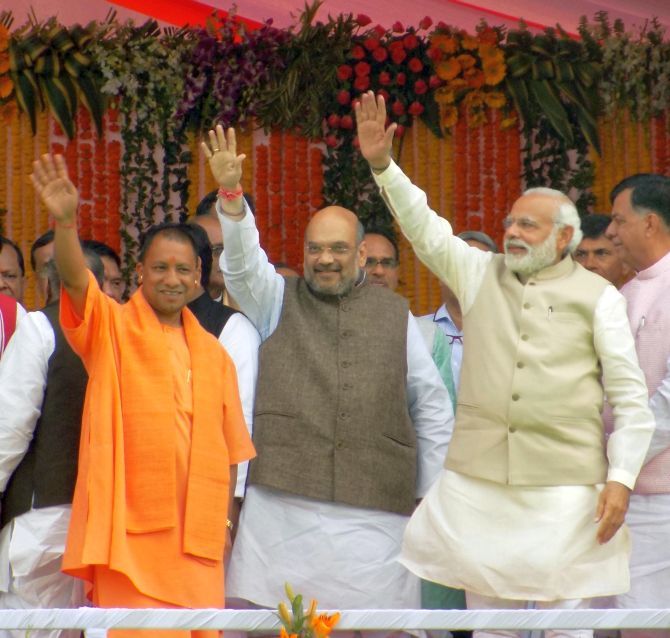
Shah had his sights set on Adityanath after the Lok Sabha election of 2014, wondering if the current CM could helm the UP unit.
He sounded out Modi on Adityanath shortly after but the duo kept quiet, anticipating that even a hint might push the ever watchful UP factions to plot counter-moves.
Modi and Shah were also aware that the Rashtriya Swayamsevak Sangh could be unreceptive, as Adityanath’s equation with it was patchy, despite their ideological beliefs.
What tipped the scales in the Adityanath’s favour resonated in the post fact reasoning offered by party leaders and supporters.
That the high priest of the ‘Gorakhnath Math’ was not identified with a caste (although he is a Rajput and the community fervently celebrated his elevation), he was ‘extremely popular’ (although it was left to Shah to discover the ‘charisma’ ostensibly latent for 19 years); he was single and, therefore, free of the corrupt practices that politicians’s families allegedly get into; he was ‘uncompromising’ on Hindutva; he was a young and a ‘tough’ administrator.
“Most important, he marked a break from the old order that ruled over the UP BJP for decades. Sinha, Rajnath and, to an extent, Maurya are part of that order. If one of them had been at the helm, the government would have seemed like an extension of the previous one, with the familiar features of corruption and nepotism,” said a party source.
Shah recognised Adityanath’s leadership ‘potential’ in 2013, when engaged in UP as a general secretary.
He spent three days at the Gorakhnath monastery in Gorakhpur. And was impressed by Adityanath’s ability to preside over a massive institution such as that, beside the young cadre he had raised through the Hindu Yuva Vahini.
Shah also noted that he merged administrative and organisational skills with political instincts.
Adityanath has never lost an election since his debut in 1998.
“He speaks of people’s issues in a straight way, without mincing words. The idea of creating the Romeo squads to protect young college-going women was first articulated by him. Although he is portrayed as anti-Muslim, he alone has the ability to convert his popularity into votes, even in seats with few Muslim voters,” a source said.
The manoeuvres
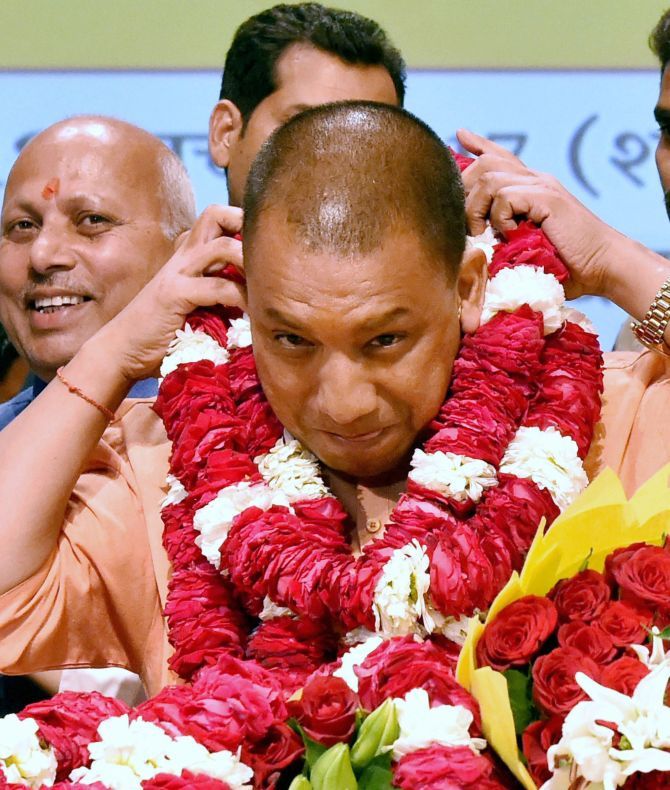
Shah had principally factored in Yogi’s sway over large sections of Hindus when he’d thought of appointing him the UP party head in 2016.
He was ‘advised’ against it because Adityanath was a red rag to a few influential leaders. The UP CM himself refused the offer, after which Shah picked Maurya.
Not that the Yogi was Shah’s perfect mascot all the time.
In a slew of by-elections held five months after the Lok Sabha poll in UP, the BJP lost eight of the 11 seats to the Samajwadi Party.
Adityanath had been put in charge of the exercise and campaigned in all the constituencies, reinforcing the message of ‘Hindu unity’ against the perceived ‘threats’ from a religious community.
It was around that time that Sultanpur MP Varun Gandhi, who for long fancied himself as a chief ministerial candidate, rekindled his ambition. Foregrounding Adityanath was Shah’s way of asking Varun Gandhi to recede.
The loss in the bypolls did not undermine Shah’s faith in Adityanath.
Aware that Yogi’s detractors could counter-strike, Shah ‘tactically’ distanced himself and did not marshal his services in the campaign for the Maharashtra polls, when he’d relocated the entire UP BJP to Mumbai, to work on the north Indian migrant voters.
Adityanath endeared himself to Modi for three reasons.
He’d adopted his spiritual ‘guru’, the late Mahant Avaidyanath as his father in place of his biological parent; to the PM, that denoted a spirit of ‘self-abnegation’.
Then, Adityanath organised the largest public meeting for Modi at Gorakhpur before the 2014 election.
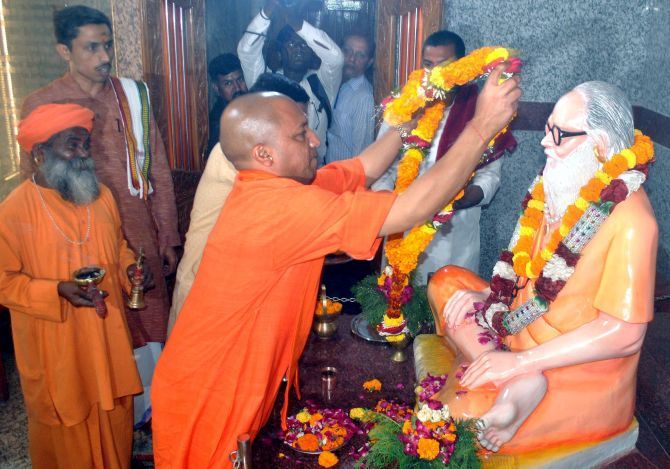
And, finally, he spoke bluntly.
“Modi was taken aback when Adityanath plainly asked him when he would revive a dead fertiliser plant and set up an All India Institute of Medical Sciences (both in Gorakhpur). Nobody he knew had displayed this sort of commitment to his constituency,” a source said.
On July 22, 2016, the PM laid the foundation stones of both projects, Adityanath by his side.
If Modi and Shah did not project Adityanath as CM, it was out of expediency.
First, the RSS was on the ground, working overtime for the BJP in the election. The leadership duo could not antagonise it by ‘thrusting’ Adityanath’s name.
Influenced by the UP leaders, the RSS viewed Adityanath as a ‘disruptor’. The Sangh never forgot that in December 2006, when the Vishwa Hindu Parishad was to host a congregation of clergy in Delhi, Adityanath called a parallel meet in Gorakhpur and spirited away high-profile Shankaracharyas and mahants from the former’s jamboree.
Fearing the rival shows might expose the faultlines in the Hindu clergy, the VHP called off its meeting and its then president, Ashok Singhal, went to Gorakhpur to be with Adityanath.
Second, Rajnath Singh’s persona continued to loom over the UP political landscape.
Rajnath never hit it off with the Yogi, suspecting the latter was out to appropriate his hold over the Rajputs.
Before the 2002 UP elections, when Adityanth figured that Rajnath, then the CM, had curtailed the latitude he had in distributing tickets, he floated his own party, the Hindu Yuva Vahini, and fielded rivals against the BJP.
Adityanath ensured many official BJP candidates lost in his fiefs in eastern UP.
The Vahini was a perennial source of trouble for the BJP.
In 2017, Shah checkmated the damage it could cause by giving Adityanath a free say in distributing tickets. He also enhanced Adityanath’s standing in other ways.
Shah let him address the largest number of rallies, 150 in all, from Ballia in the east to Noida in the northwest. And sent a special aircraft to tow him to Lucknow when he’d released the BJP manifesto.
Shah also made him the BJP’s star campaigner in the Mumbai municipal polls.
The wrap-up
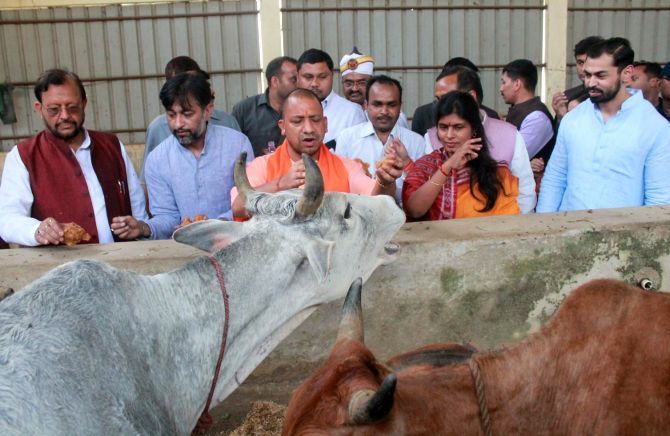
When the UP polls were in the fourth round, the BJP’s internal surveys ranked Adityanath on top of the popularity charts, although the ranking was contested by those close to Rajnath.
Rajnath was ‘consulted’ only in the preliminary stages of the talks on the CM that were called after the verdict was out.
Although Rajnath was reluctant to take on the assignment before the polls, the word was that, after the victory, he ‘was more than willing to’.
As was Maurya, who revealed his ambitions through cheerleaders like Vidya Sagar Sonkar, Vikramjit Maurya and Harish Chandra Shrivastava.
Sinha’s candidacy was apparently disfavoured by many MLAs, who conveyed to the leaders that not only did he come from a politically ‘marginal’ caste, the Bhumihar; he rarely, if ever, ensured the victories of the few Bhumihar MLAs put up in his region.
Finally, after the parliamentary board empowered Shah to elect the CM, he, a source said, chose the one who was ‘young, hardworking, honest and wore saffron robes’.
Shah individually phoned the board members and said Adityanath was the ordained one.
Barring “one or two”, who “sounded as though they had misgivings, the rest claimed they were elated,” the source said.











